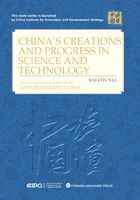
Foreword
Since 2013, CPC General Secretary Xi Jinping has emphasized on a number of occasions – for example at the National Conference on the Work of Ideological Publicity and the Central Conference on Work Relating to Foreign Affairs – that the country needs to do a better job of telling China’s stories and making China’s voice heard. In November 2013 and November 2015, the China Institute for Innovation and Development Strategy and the 21st Century Council, an internationally renowned think tank, worked together to hold two successful international“Understanding China” conferences. General Secretary Xi Jinping welcomed these conferences and expressed the view that they will serve to“build a bridge and platform of communication.” On this basis, the China Institute for Innovation and Development Strategy devised a plan to compile and publish a series of books under the title of “Understanding China,” allowing experts and academics to tell more of China’s stories. The volume on science and technology in this series intends to tell the story of China’s achievements in science and technology under the title China’s Creations and Progress in Science and Technology.
In earlier ages, European thinkers such as Francis Bacon, Voltaire, and Karl Marx spoke highly of the influence of China’s great inventions – such as printing, the compass and gunpowder – on the course of world history. They furnished a perspective on science and technology for western readers to understand China’s civilization. Naturally, the four great inventions of ancient China, which are well-known to many people, cannot fully represent China’s contribution to world science and technology. Therefore, it is necessary that some important items of China’s scientific and technological achievements from more modern times should be presented to the readers – and particularly oversees readers – so that the world can better understand the ebbs and flows of Chinese history and the great rejuvenation of the Chinese nation.
In the 20th century, Chinese and foreign academics built a more systematic understanding of China’s developments in science and technology. China was a land of invention and creation in ancient times. The Chinese people started to grow rice 10,000 years ago. They invented silk weaving technology 5,000 years ago. The Dujiangyan Irrigation System was built in the late Warring States Period (c. 250 BC). Paper making was invented in the Han Dynasty (1046-256 BC). In the Song and Yuan dynasties (960-1368 AD) Chinese science and technology reached its zenith, and important inventions emerged such as the compass, water-driven astronomical instruments, and firearms. There were also many discoveries and creations in mathematics, astronomy, medicine and agronomy. From the beginning of the 16th century, European scientific and technological knowledge spread into China through the activities of missionaries and traders. After the Second Opium War, the Qing Dynasty introduced western technologies and learned to build “powerful battleships and cannons.” In the first half of the 20th century, the Chinese people developed science and technology education and scientific research institutions, but their scientific and technological effort struggled to advance during long periods of warfare.
The foundation of the People’s Republic of China created an opportunity for the great development of scientific and technological undertakings. New China formed several scientific and technological forces such as the Chinese Academy of Sciences, higher education institutions, and industrial scientific research institutes. It introduced foreign technologies and built a relatively complete industrial and technological system. It achieved major steps forward in scientific and technological research as represented by “Two Bombs and One Satellite,” which promoted remarkable economic and social development. Since the beginning of reform and opening up, China has continued to introduce, digest and absorb foreign science and technology. It has endeavored to enhance its capability in independent innovation and has achieved startling results in many areas. Following the 18th CPC National Congress, the state implemented the strategy of innovation-driven development and proposed the goal of building a powerful country in science and technology. This points the general direction of the development of science and technology in China.
Undoubtedly, only through understanding past, present, and future trends in China’s science and technology can we better understand the country’s development, and come to grips with the strategy of innovation-driven development and the Chinese Dream of national rejuvenation.
Bai Chunli
March 2018